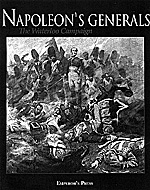
Title: Napoleon's Generals: The Waterloo Campaign
Author: Tony Linck
Pages: 352 large pages
Illustrations:104, b&w, including many portraits by Keith Rocco
Maps: None
Footnotes: None
Appendices: 3 (19 pages), including avery detailed fifteen-page order of battle for the French Army of the North in June,1815
Bibliography: 80 sources, not differentiated as to primary or secondary
Index: None, but one appendix is a matrix showing each General's service history
Publisher: The Emperor's Press,Chicago, Illinois
Publication Date: None listed, but publisher confirms release date as 1994
Binding: Cloth (hardbound)
Price: $35.00
ISBN: 0-9626655-8-4
Summary: An entertaining reference work containing concise military biographies of each man who attained the rank of Major General (or higher) and served in the French Army of the North in 1815.
This book is a valuable encyclopedia on the generals who led Napoleon's last army to arguably the most famous defeat in history.
As Mr. Linck states in his preface: "This book is not another analysis of Waterloo, but brings to light the often ignored careers of the men who were largely responsible for the implementation of Napoleon's style of warfare." Thus, Mr.Linck is even handed in his coverage, showing no deference to the careers of Napoleon's Marshals, who have received enormous attention and coverage both during and after their time.
Each of the 70 biographies is divided into sections covering the different campaigns and phases in a general's career. The Waterloo campaign is not necessarily given more weight or space than other adventures. Especially enjoyable is the careful attention paid to the often fascinating post-Napoleonic political and military careers of these men. Each biography closes with a pithy evaluation of the General's entire service.
In looking in more detail at only one example, the section on General Cambronne devotes more space to his background and early career, where he served with Moreau's Army of the Rhine and earned himself the title of the "Second Grenadier of France," than it does to Waterloo, where Cambronne's last stand achieved popular immortality and lasting controversy.
As for Cambronne's alleged "merde" epithet in response to being asked to surrender, Mr. Linck believes that words close to "The Guard dies but never surrenders" probably were uttered rather than "saltier" versions of the episode. (There are two paintings of the incident included with the chapter, one romantically glorifying Cambronne's defiance facing the other picture portraying his humiliating capture - a rather nice touch.)
There are some wonderful appendices included with this work that are of special interest to wargamers. Mr. Linck has included an Order of Battle for the Army of the North that displays regimental returns for the 15th of June as well as for the 25th of June, thus enabling a before-and-after comparison of unit strengths, and which provides a sobering statement to the cost and to the decisiveness of the French defeat.
Another nice feature is the previously mentioned career matrix, which quickly shows the campaigns in which each of the featured generals served. As a final treat, Mr. Linck has stuck his neck out and given us an evaluation of each officer rating them (on a scale of one to ten) in the four areas of control, attack, defense and independent command.
According to Mr. Linck, more than 400 men attained the rank of Major General in the French army during the Napoleonic and Revolutionary Wars. Here we find the worthy biographies of seventy of them.
More Reviews
Back to Empire, Eagles, & Lions Table of Contents Vol. 2 No. 10
Back to EEL List of Issues
Back to MagWeb Master Magazine List
© Copyright 1995 by Emperor's Headquarters
This article appears in MagWeb (Magazine Web) on the Internet World Wide Web.
Other military history articles and gaming articles are available at http://www.magweb.com
